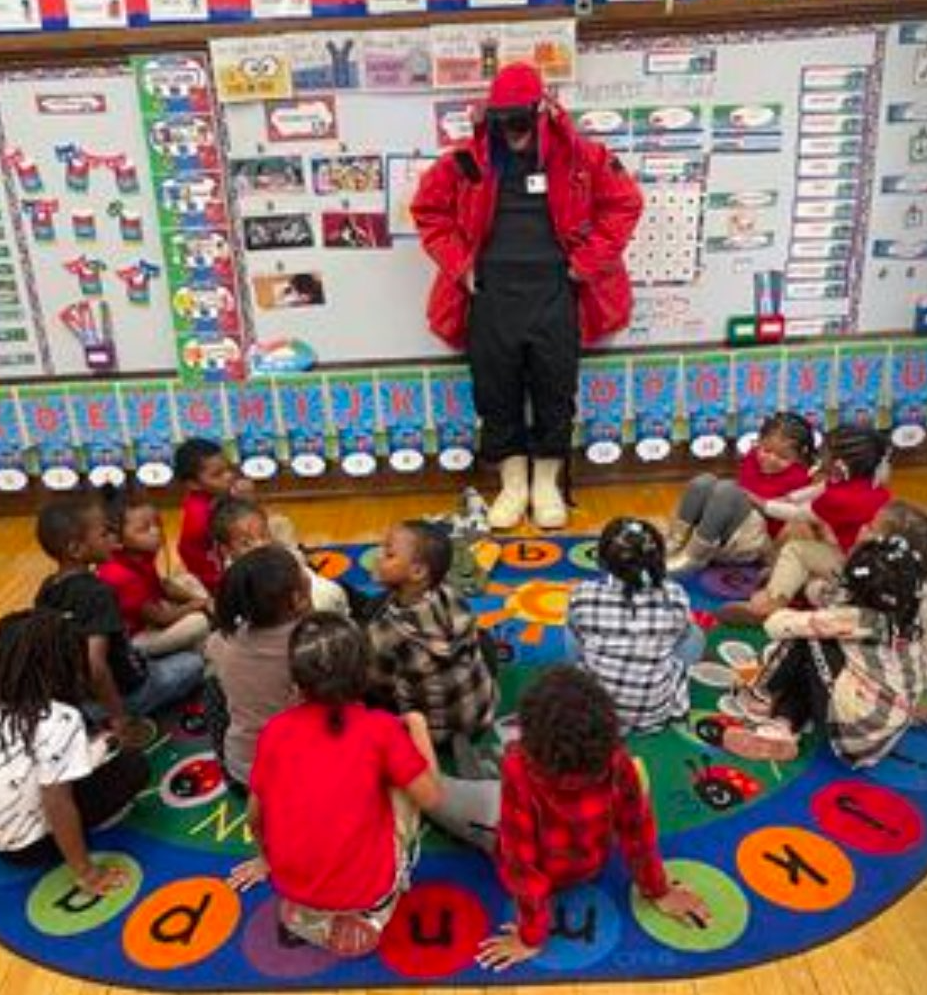
Graduate student Paul Chichura showing off some of the extreme cold weather gear to kindergarten students.
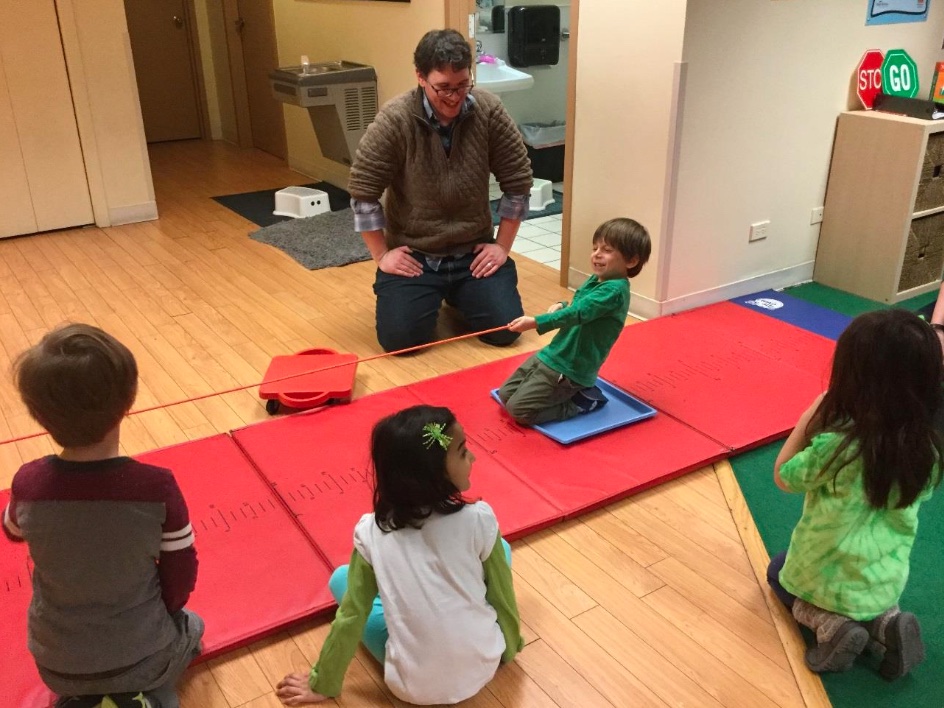
KICP fellow Dr. Jason Henning running a lab designed to teach students about the properties of friction.
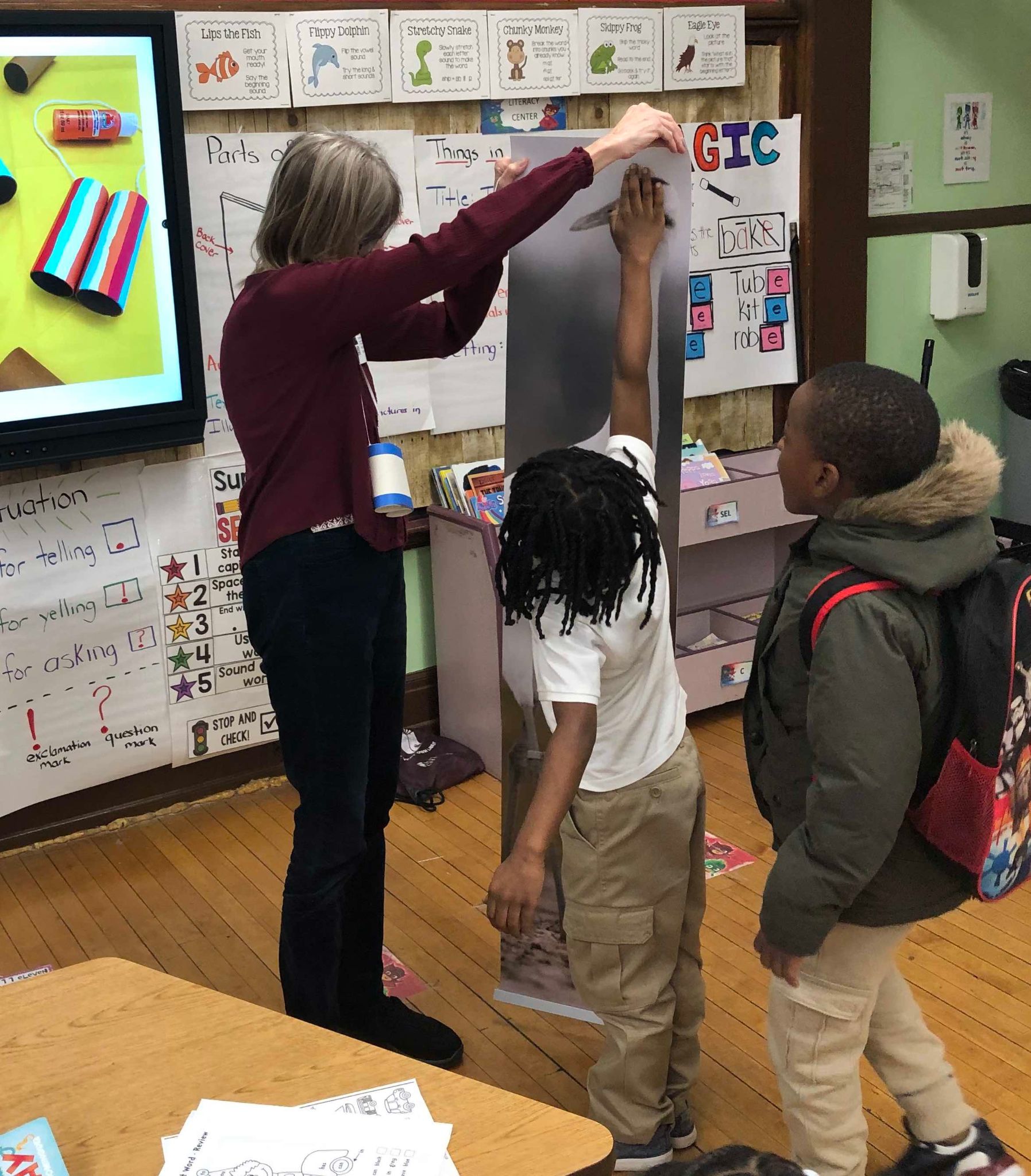
Physicist Donna Kubik teaching students about how to make observations of and learn about birds.
CMB Instrumentation Summer School
We run a 1-week "hands-on" summer school designed to provide participants with working knowledge of the detectors and instrumentation used to measure the cosmic microwave background (CMB). Bi-annually at U. Chicago, we host approximately 15-20 students, aimed at senior undergraduates and early graduate students interested in pursuing a PhD in experimental physics or astrophysics.
Topics include: superconducting detectors, transition edge sensor (TES) bolometers, kinetic inductance detectors (KIDs); detector characterization, including beams, bands, time constants and polarization calibration; cryogenics and mm-wave optics; coherent and holographic techniques for characterizing optical components; and Fourier transform spectroscopy.
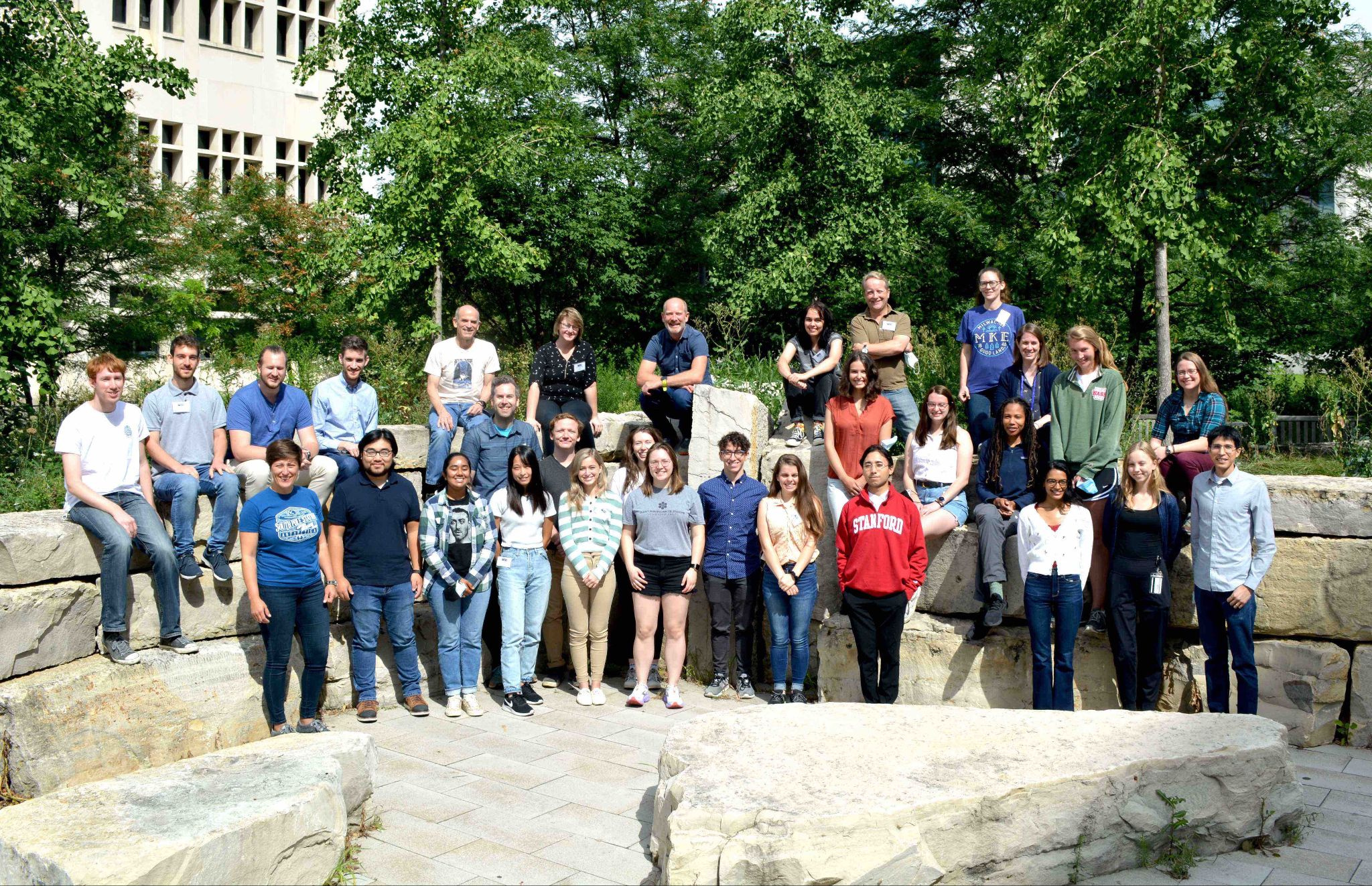
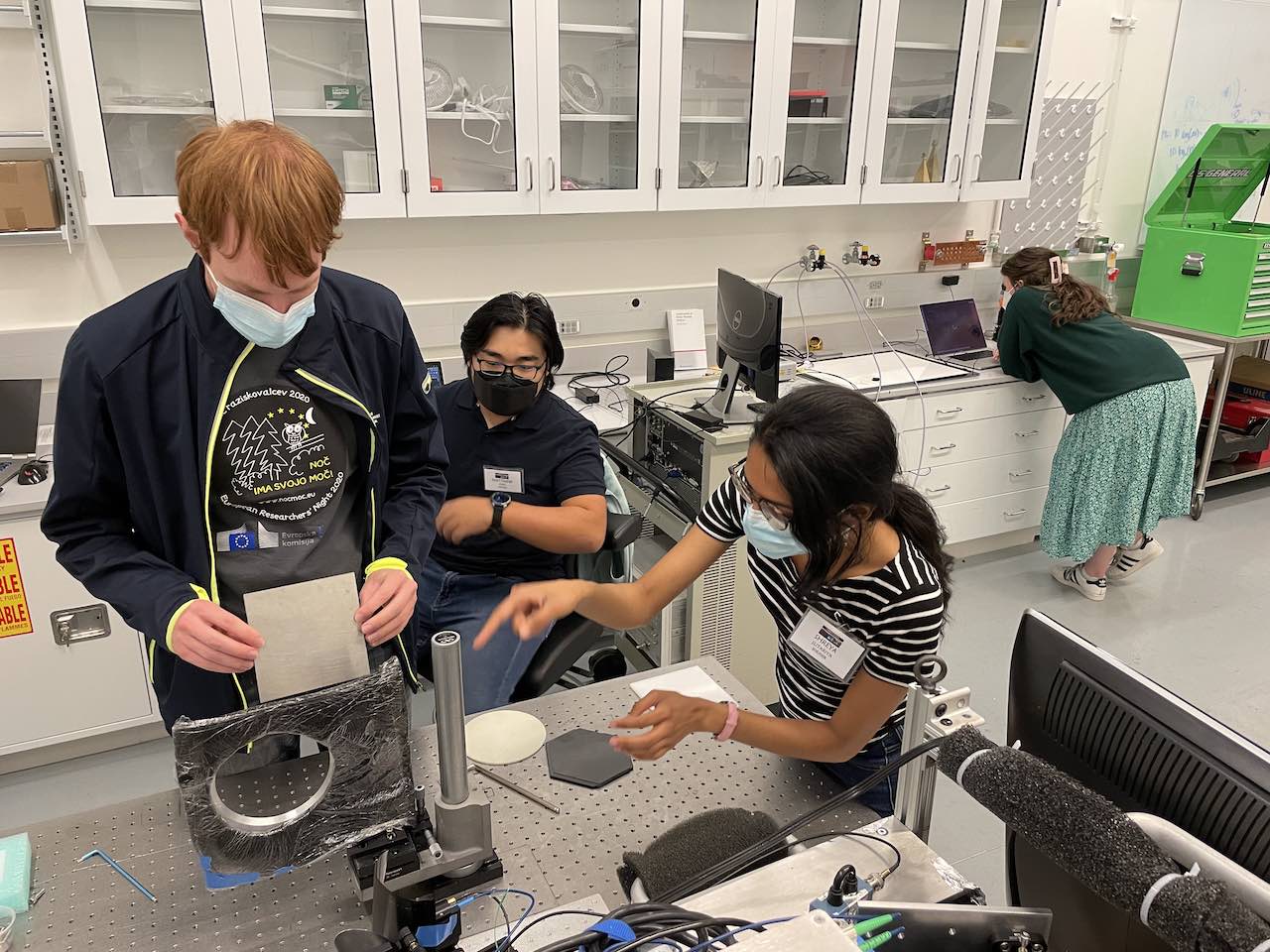
Laser spectroscopy lab, designed to measure properties of mm-wave materials, including index of refraction, tranmission, and reflection. Led by graduate student Shreya Sutariya.
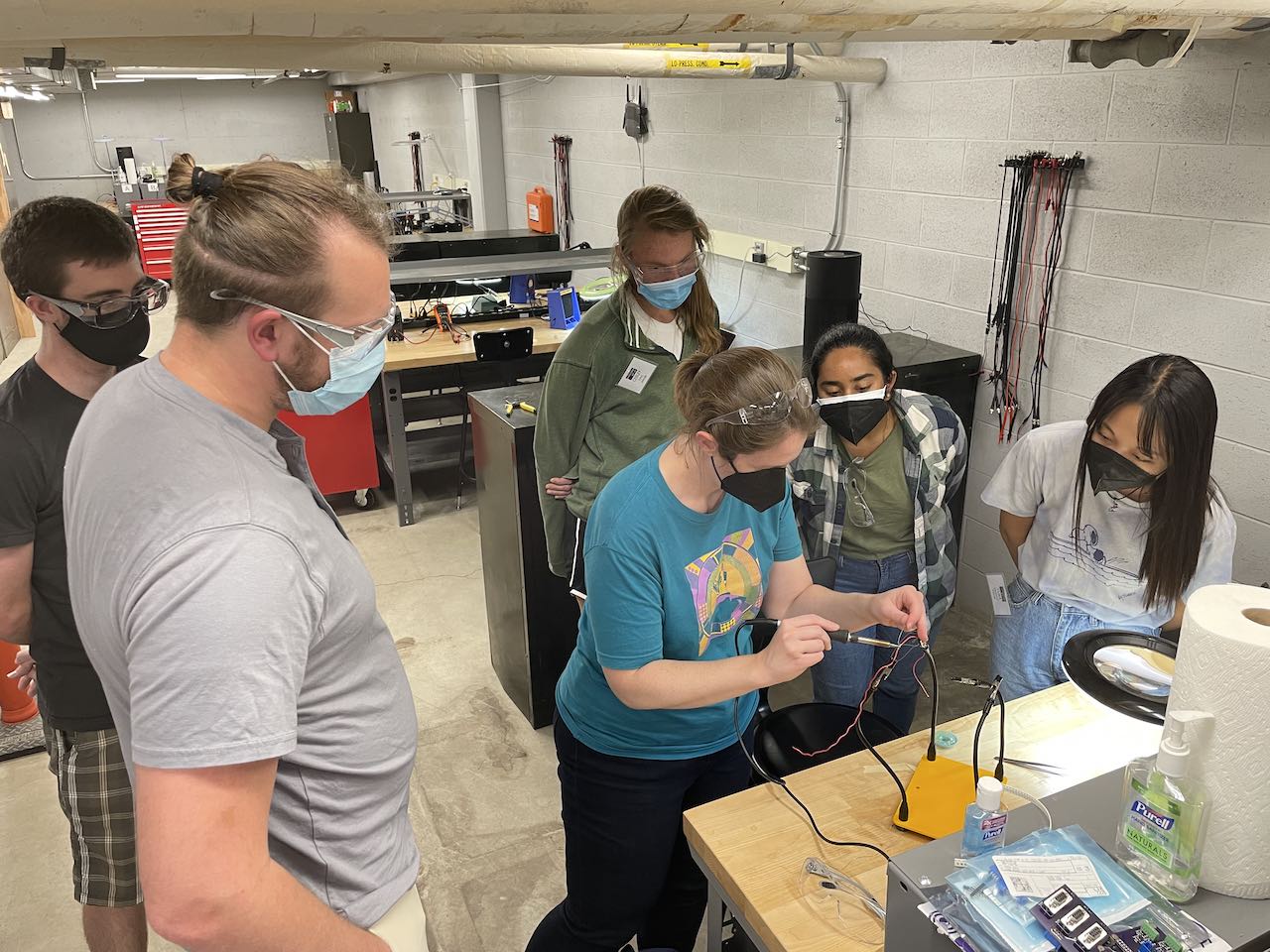
Soldering lab, designed to teach students the basics of laboratory electronics and soldering. Led by Dr. Amy Bender.

Making liquid nitrogen ice-cream at the summer school dinner.
Joliet Junior College STEM Scholars Attend UChicago summer REU
The South Pole Telescope group at UChicago had three interns from Joliet Junior College for the summer of 2024. In the following interviews, these interns describe their academic path, their goals, and passions. Aspiring interns and students can glean valuable insights from the Joliet Junior students’ experience with the undergraduate research internship.
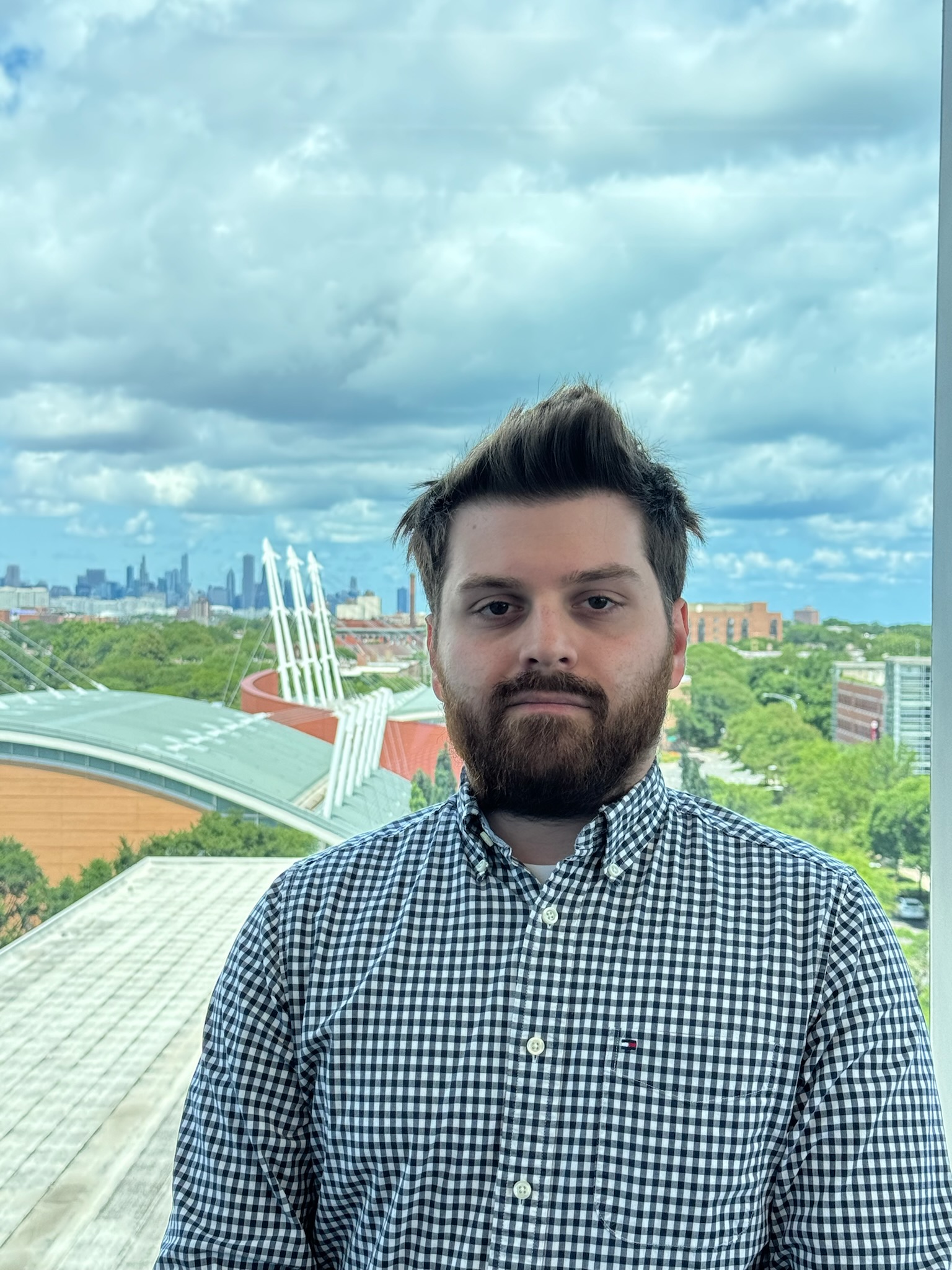
Wolfgang Struven
Wolfgang Struven is a sophomore at Joliet Junior College. He’s currently on track to transfer to the University of Illinois in Urbana-Champaign. Wolfgang intends to major in astronomy and then go into graduate school focusing on astronomy and astrophysics.

Alison Kubistal
Alison Kubistal is a sophomore at Joliet Junior College. She’s going to be starting at North Central College in Naperville in the fall. Alison intends to major in mechanical engineering and enter the workforce.
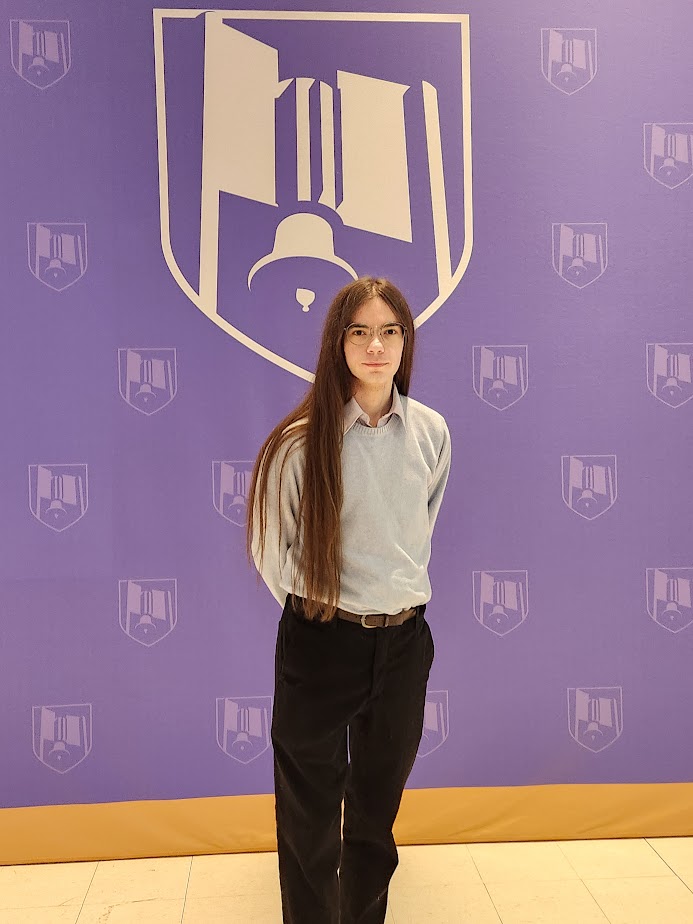
Casey Garret
Casey Garret is currently a sophomore at Joliet Junior College. They are working on finishing their associates and afterward plan to work for a bachelor's in nuclear engineering at Urbana Champaign. They hope to eventually work at Argonne or Fermilab.
Tell us a little about yourself

My name is Wolfgang Struven. I am 23 years old. I am a student at Joliet Junior College. Technically I would be going into my junior year. I tried starting college post-pandemic, but I wasn’t ready and had to take a gap year.
I’m currently on track to transfer to UIUC soon, hopefully to graduate in late 2026 or early 2027. I also just got engaged, and plan to be married in either April of 2026 or 2027.
Tell us a little about yourself

My name is Allison. I'm 20 years old, and I'm going to be a junior and starting at North Central College in Naperville.
I plan on becoming a mechanical engineer. I have about two and a half years left of school. Two years at Joliet Junior College, and then two more at North Central.
I hope to do my four years, get my bachelor's, and go into mechanical engineering with that. Just get a job from there and then see, maybe research, but just that's where I'd wanna go.
Tell us a little about yourself
I’m Casey Garrett. I am 22 years old and a sophomore at Joliet Junior College.
I'm working on finishing my associate's right now, and once I do that, I'm going to move on to working for a bachelor's in nuclear engineering at Urbana Champaign.
Early on, I went to Western Illinois University, year 2020, and failed that, and then later went back to school at Joliet Junior College. At the time I was looking into pursuing a degree in mechanical engineering. But as I went through and took more and more chemistry classes, I found out exactly how much I enjoyed doing chemistry and different types of chemistry. I was like, hey, actually, I think I could do this for a living, and change my aim toward nuclear engineering, And that’s where I'm at now, working toward that.
I plan on trying to work towards being a nuclear operator. But also, I think if given the opportunity, working at some place like Argonne or Fermi, doing nuclear engineering stuff would be really, really cool.
What research area are you the most interested in?
I've actually been doing some research of my own. I was originally under the guide of a professor at U of I but not any longer. It was originally my idea to do the research, which is to look for a nebula in the New General Catalog, or the NGC that was lost over 100 years ago. No one knows what happened to it. It could have been an erroneous observation, or a duplicate observation, which is what many have theorized it to be. But what really drew me to it was that the name of it is Struve’s Lost Nebula and was discovered by Otto Wilhelm von Struve. He has the same last name as me, and as I would later find out, I am distantly related to him.
That's originally how I discovered this nebula, or discovered it in the catalog. Why is there a nebula with my last name on here? That's partly what inspired me to do that research. But it has now kind of turned into this whole fascination with the interstellar medium (ISM), because this research is essentially an ISM project. The nebula was seen near the original T Tauri, which its name was then applied to a whole class of stars. It’s basically like the teenage years of a star. And this nebula, if it exists, is basically in the ISM around the star, no less than half a light year from the star.
The ISM really fascinates me, especially since the Voyager One and Two spacecraft that we launched in 1978 finally started to enter the ISM. They've taken some very fascinating readings. Another distant relative of mine who was an astronomer, actually was director of the Yerkes Observatory, Otto Struve, grandson of Otto Wilhelm von Struve. He was a pioneering researcher in discovering that there, in fact, are clouds of gas in interstellar space by isolating their spectral lines from background objects. The ISM fascinates me, because it could be either the next generation or the one after that could be going into interstellar space, going to distant stars. I would love to understand that because if we end up colonizing distant planets, we should at least have a good understanding of the vast sea of space to get there! To me, studying the ISM like trying to build a map of unknown lands, sort of like cartographers of old. Ferdinand Magellan, for example.
That’s actually part of what drew me to the South Pole Telescope program. I really like the South Pole Telescope because Antarctica itself is very fascinating. It's essentially the final frontier of the earth. When you're there it feels like you're on another planet. It's so inhospitable to life. You might think, “Well, why is that cool? Just sounds awful.” To me, it’s because it's like you're on another planet. It's like you're on the cusp of human knowledge.
What’s your inspiration for going into mechanical engineering?
My mom took me to a Girls in Engineering Day at Olivet Nazarene University when I was 10. She took me there and they had games where you could build stuff. So I thought that was really interesting. And then from there, she gently guided me in that direction. And then I've just liked it ever since.
I’m minoring in environmental studies, so I'm hoping to build machines that'll help the environment. So machines along that line, building, problem solving, to help the world we live in.
I’m thinking places like Exxon Mobil because they're environmentally friendly, and they're working towards that sort of thing.
What motivated you to pursue nuclear science?
I'm a first-generation college student, but growing up, I remember that my dad was always a bit of a technophile. He was really into science and astronomy and cosmology and all that. I remember watching a bunch of those space shows in the background when I was a little. I would say that's probably most of the inspiration I got in order to go, “Oh my god, this is so awesome. I'm so happy I get to do this.”
Can you provide an overview of what you're working on for the SPT group?

Right now the SPT group is designing the new camera for the South Pole Telescope. Because technology keeps getting better, particularly lithography technology, which is the actual designing of electronic chips, like the one on your phone, for example, was made via lithography, probably in Taiwan. But we have our own lithography lab here, and we also have one in Argon. We are making iterative improvements on the sensor for this telescope. And right now we're designing the fourth generation. We've had a new generation roughly every five to six years.
But for me, I am designing an optic coupling between something called a Fourier Transform Spectrometer, or an FTS, and a test cryostat down in the lab. A lot of it has involved me having to learn this new program I've never used before called ANSYS Zmax Optic Studio. The guides for it online are very, very limited, because the license for it is about $10,000 a year. It's very much a professional-grade piece of software, and I was not prepared to use it. I thought I would be, and it's been challenging, but I'm slowly figuring it out. I'm actually doing pretty good now in terms of my understanding of the software. This is all so we can test what's called the spectral response of the prototype detectors that we are making because we want to make sure that they are sensitive to the specific frequencies of light that we want to look at.
The equivalent for your smartphone’s camera would be to make sure that your phone is as sensitive to light as your own eyes. Otherwise, when your phone takes a picture, it's gonna look completely wrong. For example, being too green, purple, or red. That's essentially what we're trying to do, except we're trying to tune it to the cosmic microwave background, to be sensitive to that, but also so that it looks through what are called atmospheric windows, because there are certain molecules in the atmosphere that will absorb microwave light, like water, and we don't want to observe those frequencies, because that will contaminate the data. So we need to make sure it’s not sensitive to those frequencies, but sensitive to the frequencies that do go through the atmosphere. That's more or less what I've been doing these last weeks.
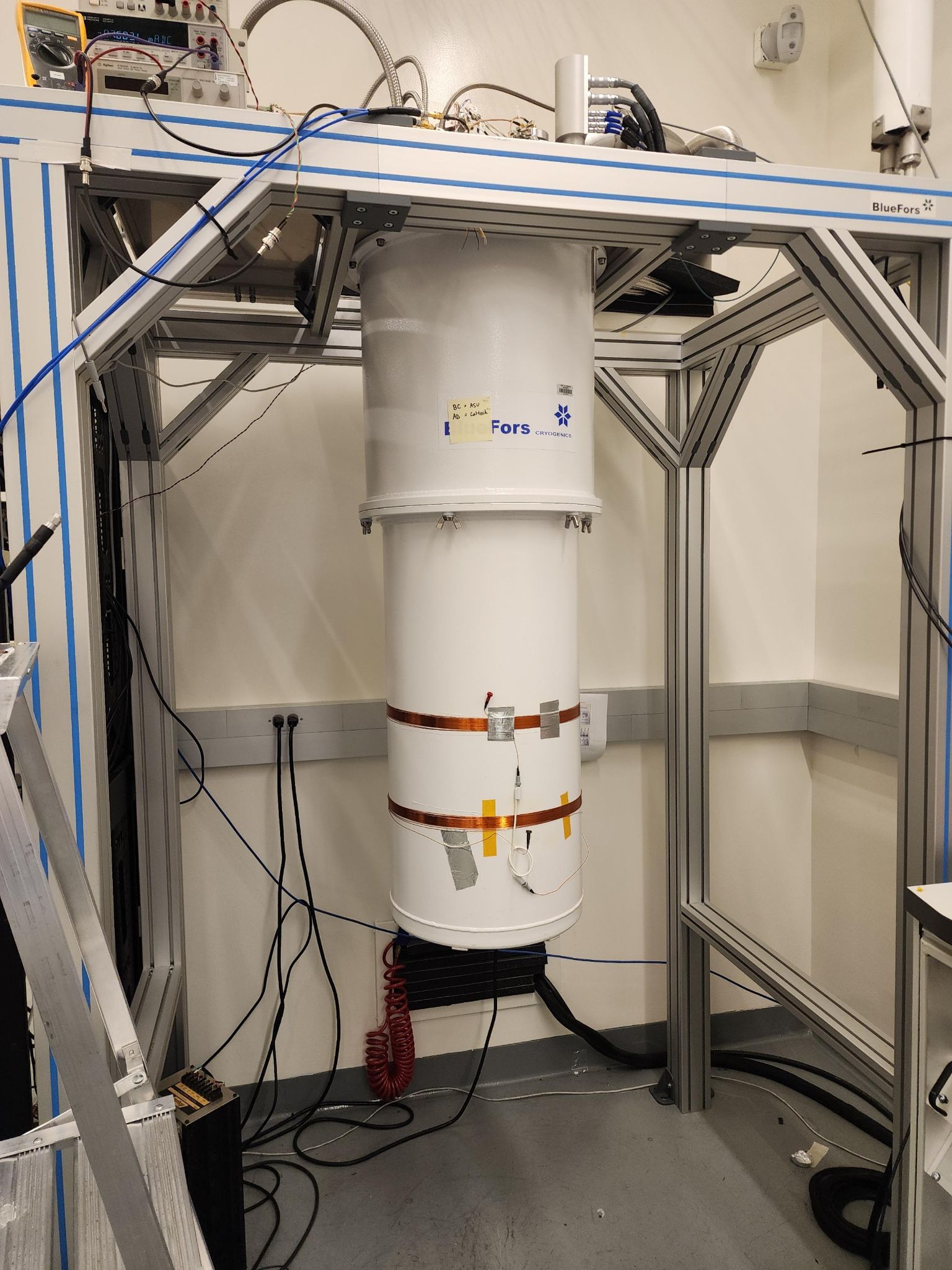
Can you provide an overview of what you're working on for the SPT group?
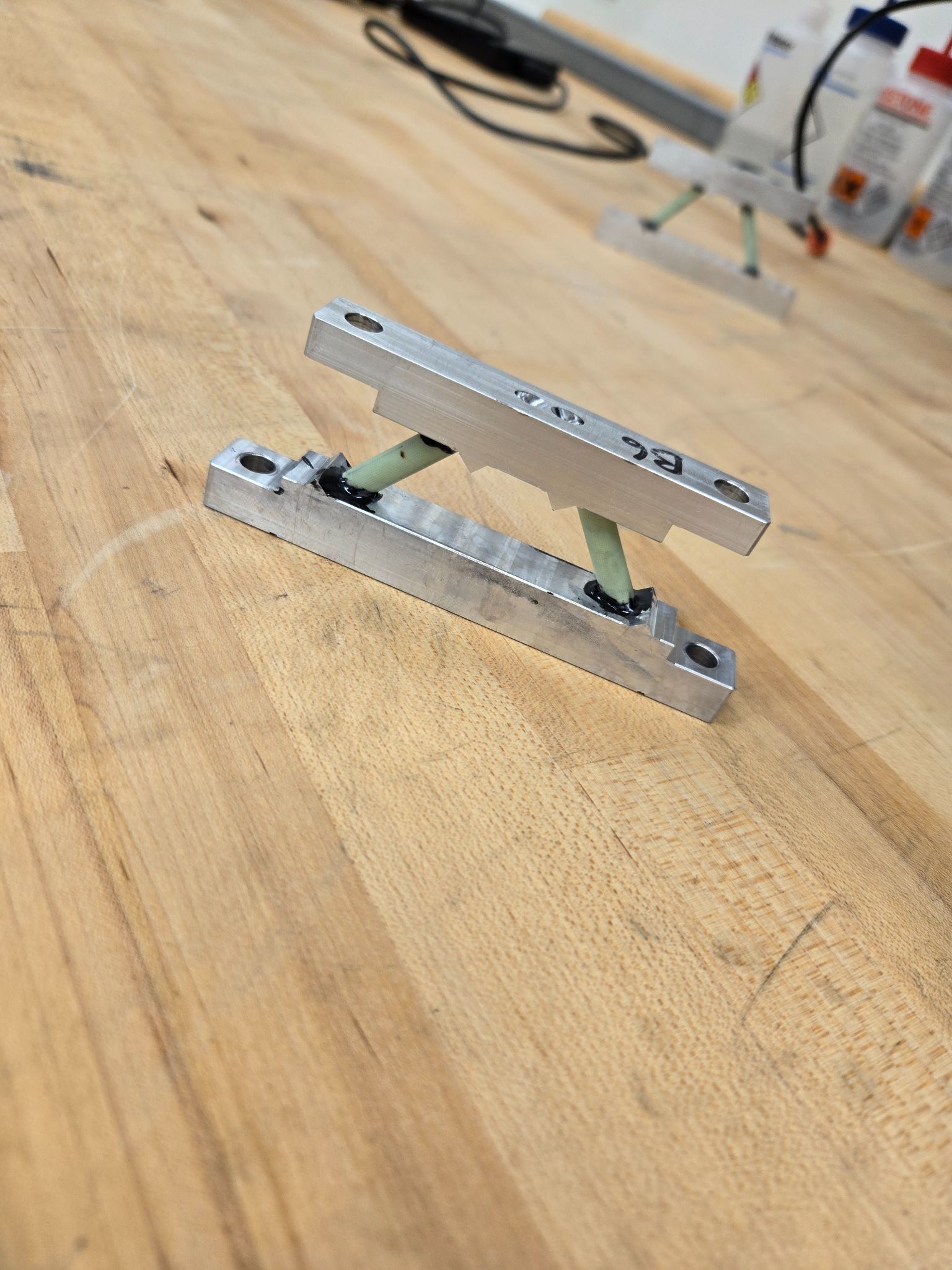
We are working on cryogenic supports, which are like feet for the South Pole Telescope camera. They're building a new camera. So they're redesigning the cryogenic supports. These are basically supports throughout to separate the thermal layers of the camera. We're building it, we're designing the supports, and we actually just sent in to have the pieces sent to us, so that we can build them and test them. Not sure we'll get that far, but that's the plan, to put them together and test like with different weights to see what they can withstand.
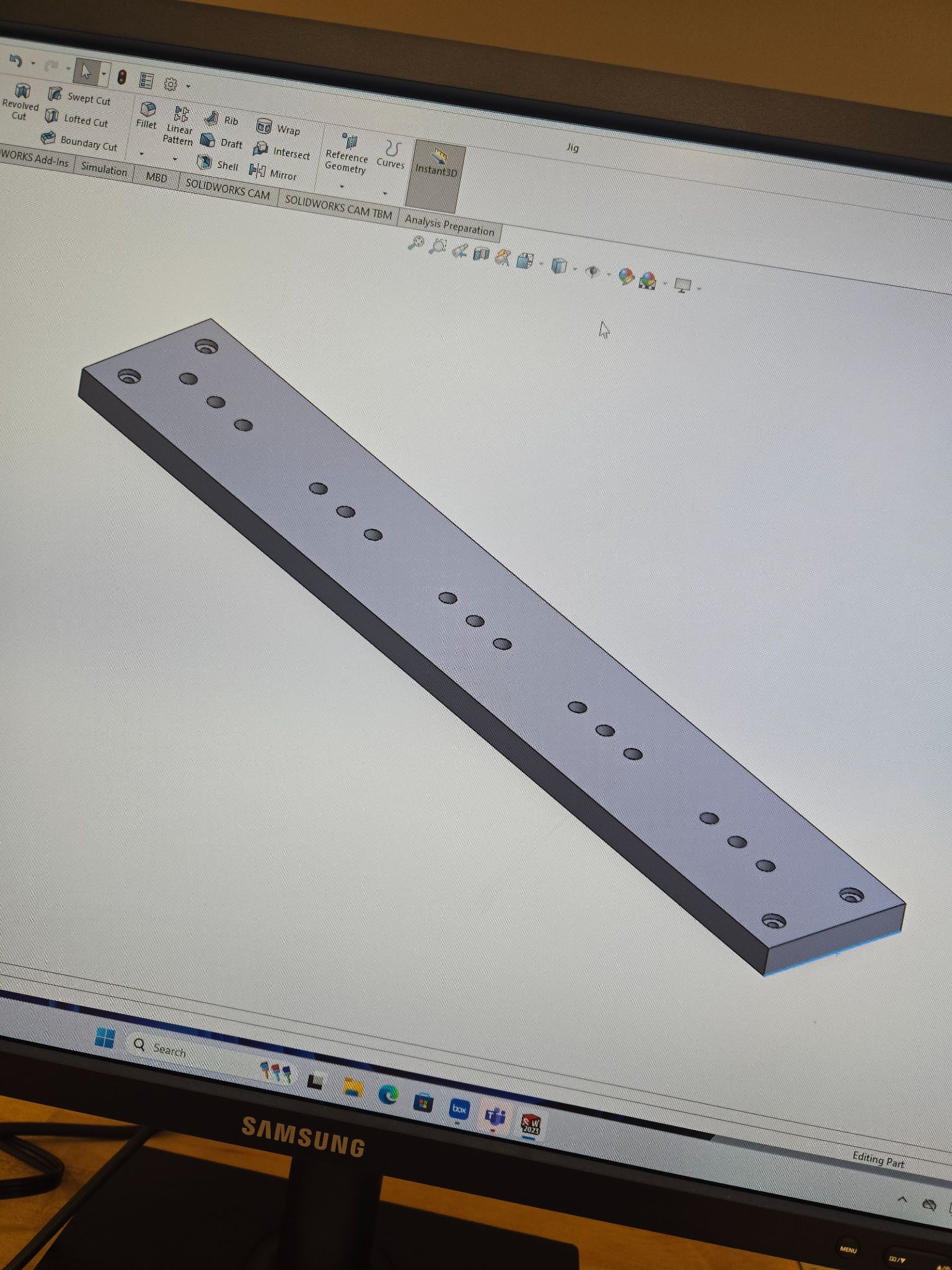
Can you provide an overview of what you're working on for the SPT group?
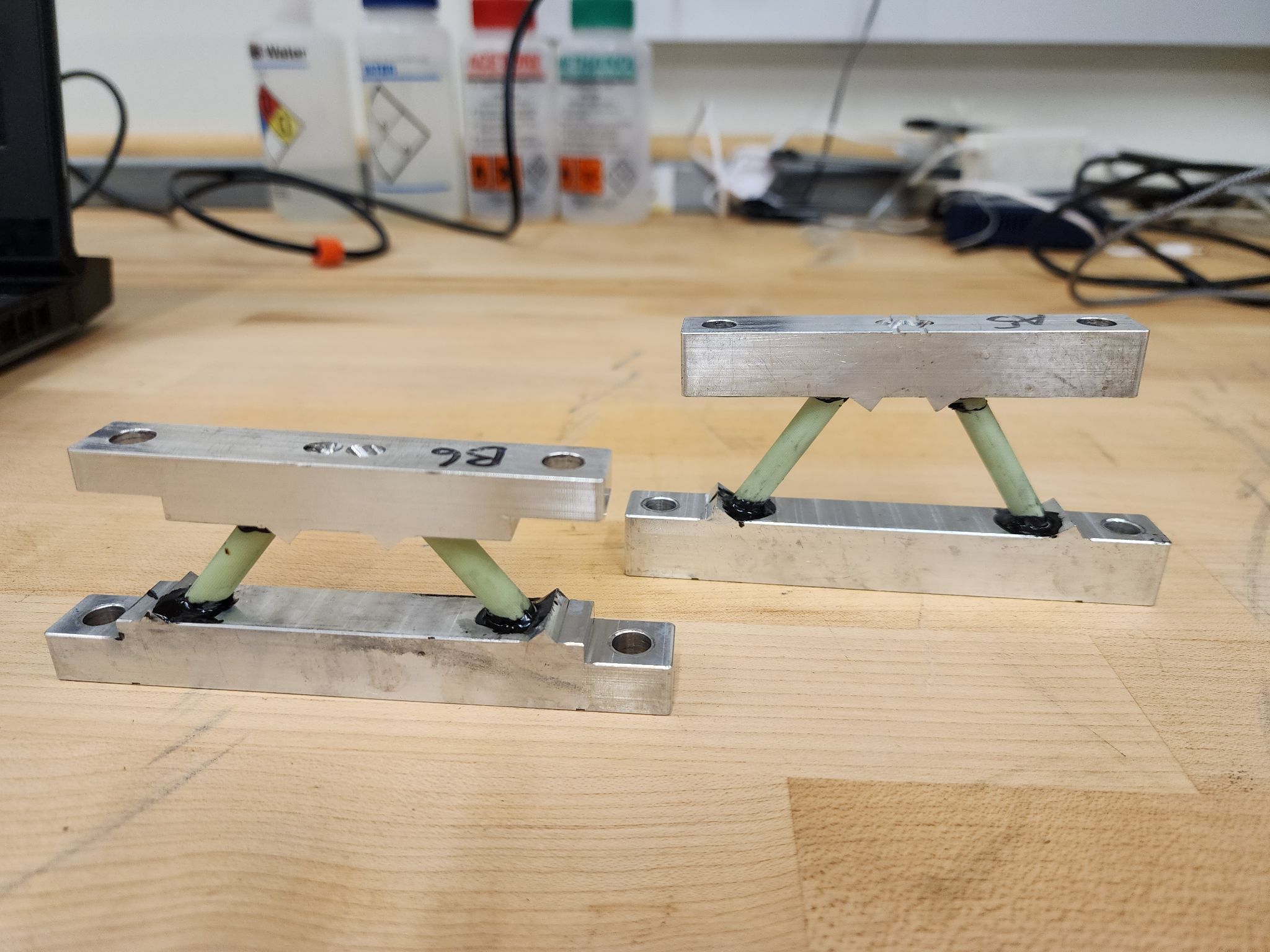

Me and my partner, Alison, and the person overseeing us, Alec, are working on developing the support struts for the interior of the upcoming telescope for the South Pole Telescope program.
The entire telescope has different stages of cooling, and it's put in a vacuum in order to try and minimize thermal bleed. We need to keep as little points of contact as possible because it's in a vacuum. So by minimizing different points of contact, it can stay colder for longer and it’s easier to cool. So we got to design struts in order to lift it up so that it's touching as little things as possible, keep it held aloft.
We had a pretty rocky start, but it's starting to really pick up pace. What we're trying to do here during our internship is get data on what the design should look like, not the actual finished design, but decide on what path we'll take for the final design. Right now we have all of our 3D files done, I believe. I'm working on getting quotes for all of it, and then we're going to order it and assemble it in lab, and then we're going to start doing some stress tests. And that's the goal.

How has your collaboration with the other scientists and mentors enhanced your experience here?
It's made me appreciate just how diverse the perspectives on science can be. It has also made me kind of feel more at home. This isn't just a regular nine-to-five, it is really just you and a bunch of smart people getting together to solve this really cool problem or complete a really cool project. In the end, it's like, hey, we did something really, really cool. We just measured something from, literally, on the other side of the universe. I'd say working with other people has made academia far less intimidating.
Did you encounter any challenges during your internship?

With the programming, it's definitely an adjustment. We use SolidWorks here. In the past, I've used AutoCAD inventor. It's been an adjustment all around to learn the programming, which slows you down on your project, but they're similar enough to where it didn't take a huge amount of time. And Alec was very helpful because he knows the program really well, so he gave me tutorials and stuff like that. It's been very helpful.
I think they're very open to be there whenever you need help. Obviously, everyone has their own jobs to do. So finding time to meet can be a problem. But I find everyone's like, “I have this this amount of time, let's meet then and go over everything”. So they're very good at keeping up with you and making sure you're doing good, making sure everything's going the way it should, so you don't feel like you're alone at all.
How has your integration into the research and work environment gone?
The chairs in here are uncomfortable for long ends of time. But other than that, it's been It feels self-led, which is interesting. I enjoy all the people here. It's nice talking with people who are very smart and generally knowledgeable in their fields. And the work itself is, I'd say it's decently fulfilling. I've been enjoying it here.
I’ve mostly been working with Dr. Benson and Alec, and they've both been very busy throughout the entire part. Brad seems to have more than a full plate, but they've given me and Alison enough guidance in order to try and actually undertake the task. It's mostly been like a guidance thing, and trying to catch us up on all the classes we haven't taken. We're the JJC students here, so we are slightly less prepared for this, but, at no point have I felt that they have inadequately prepared me.
What are some of your hobbies?
Wolfgang is a talented astrophotographer and has multiple detailed photos on his Instagram page @wolfgangstruven. Below are some samples of his work.
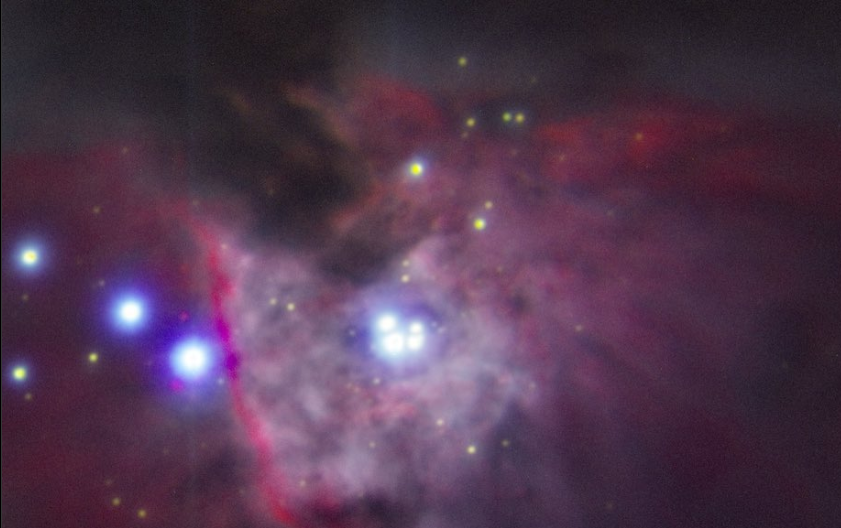

What do you like to do in your free time?
I work in a dog shelter, so I spend a lot of time with animals. If I'm not at home with my three dogs, I am working at the shelter I work at with like 80 dogs. That takes up most of my time.
I love to crochet, but it's not easy. Once you get the hang of it, it's fun, but, yeah, like little hobbies like that, just picking up little arts and crafts to fill the time. But most of my time is taken up by animals. If it's not science, it's dogs.
I pretty much always grew up with an animal. We get rescue dogs. Where I got my dog from is where I applied to work. Like my dogs are from where I work. Then I got another dog after I started working there because it's hard not to. You fall in love with them.
The oldest is Hazel, and then the middle one, we got her and then I started working at that place, her name's Grace. The youngest one is Zennie. He was a foster fail. We were fostering him, and we weren't planning on adopting him at all. We had him for a couple of months and no one was interested in him as a puppy, which we thought was strange. So we ended up falling in love with him when we adopted him. We've had him close to two years.

What do you like to do for fun?
I like to cosplay! I do a lot of video game stuff, along with other things. I'm working on a Borderlands cosplay for Gen Con. Speaking of Gen Con, I do a lot of gaming of different varieties: online, tabletops.
Cosplay can be very involved, and I wish I was slightly more motivated to do it.
EVA foam is my beloved. I make a lot of armor, I want to get more into sewing. My mom is something of a seamstress, so I, in theory, have no excuse for not being able to work a sewing machine that well. I gotta catch up.
I like to play D&D when I can. Artificer, bit of a trope here. However, I mostly DM. It’s not that I love telling stories, it’s that I know the rules the best and I’m the most willing to DM, so I end up doing it a lot.
CMB-S4 Online High school Course
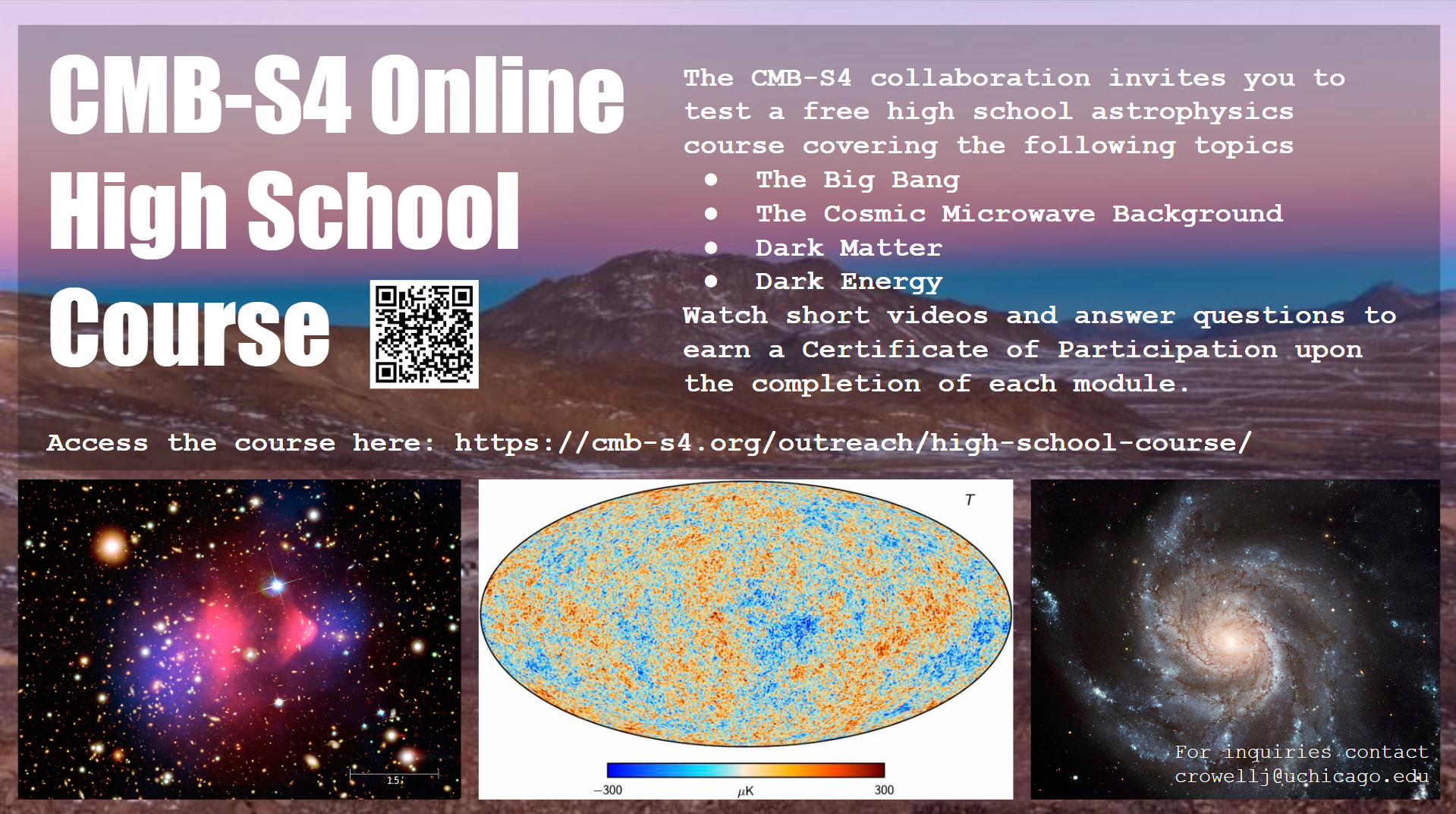
The CMB-S4 collaboration is offering a free high school astrophysics course. This course is designed for students interested in deepening their understanding of cosmology through rigorous content and engaging activities.
The course starts with four topics.
The Big Bang
Cosmic Microwave Background (CMB)
Dark Matter
Dark Energy
Students can navigate to the High School Course page of the CMB-S4 website and follow the instructions there. The course consists of short videos paired with questions along with simulations to enhance understanding of these topics. A Certificate of Participation with the final score will be given upon the completion of each module, with a total of four possible certificates.
While this is designed for high school students: teachers, parents, and amateur astronomers of all ages are welcome to take it.
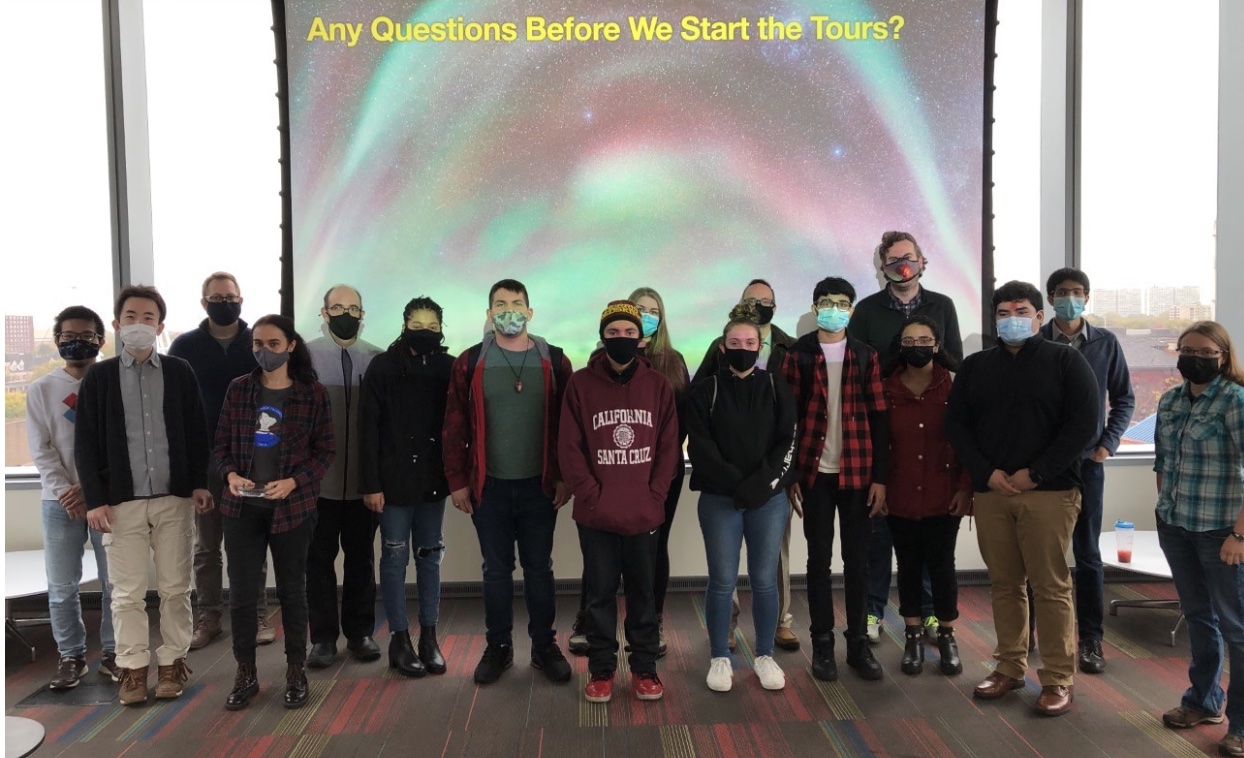
Sharing the Excitment and Science Communication
Cosmology, the South Pole (and Antarctica), and Telescopes are exciting to a diverse audience, and provide a hook for teaching many scientific concepts. SPT collaboration members routinely participate in numerous outreach activities, including: giving tours of scientific facilities to K-12 and junior college students; producing online scientific content and videos; volunteering to give online or public lectures through many outside programs, including at Adler Planetarium, Life Long Learning lectures at Senior Centers; Saturday Morning Physics, and participating in local science festivals.
Dr. Sasha Rahlin in a youtube video describing the SPT telescope and science

Graduate students Wei Quan and Paul Chichura showing a hands-on demo at the South Side Science festival.
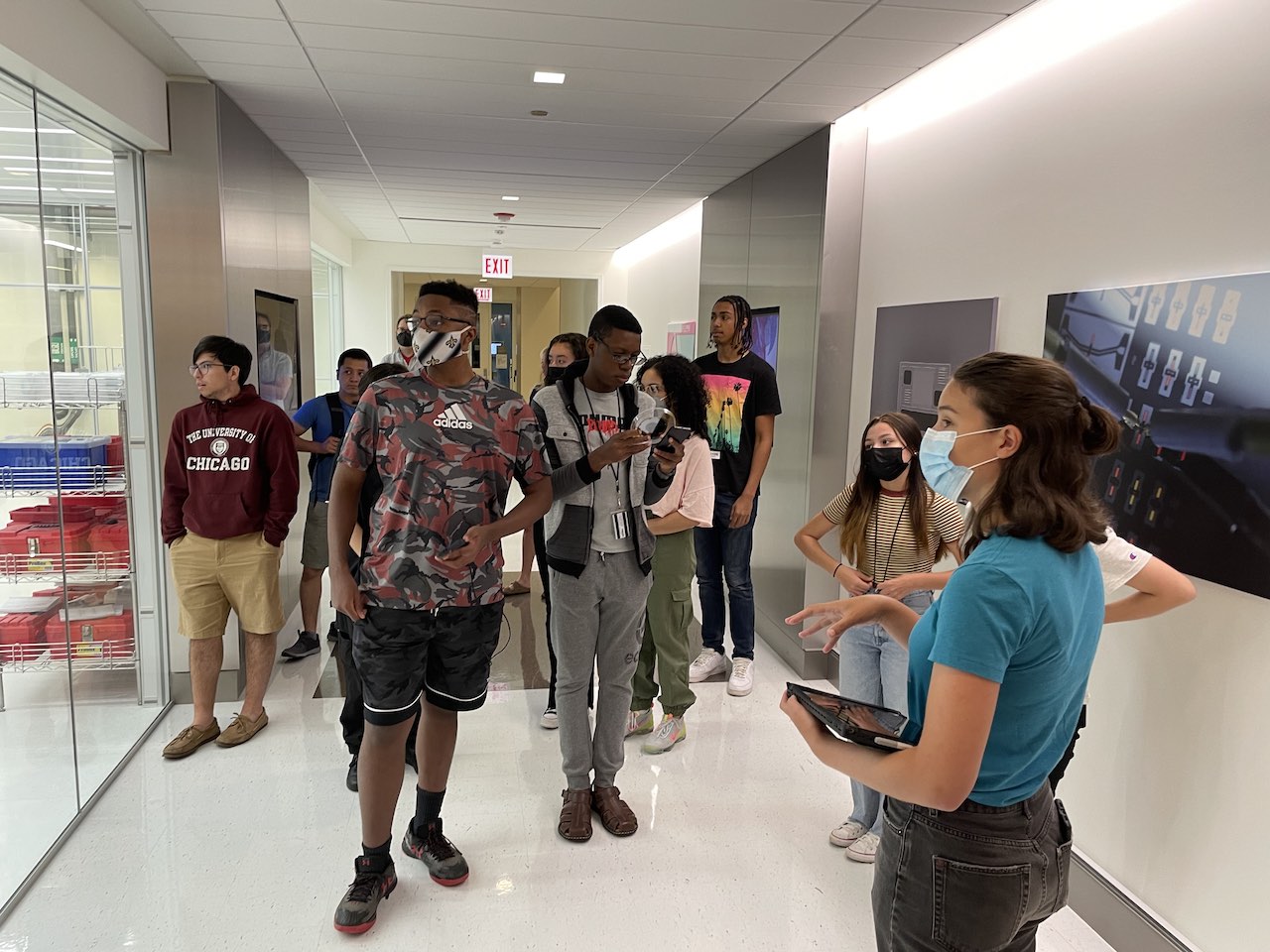
Graduate student Kyra Fichman giving a tour of the Pritzker Nano-Fabrication (PNF) facility at the University of Chicago to high school students in the KICP Space Explorers program.
Kechizu Kechizu

